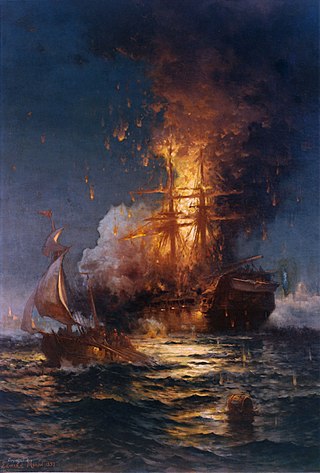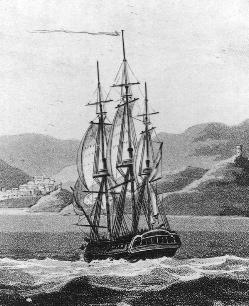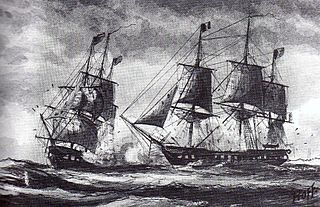
William Bainbridge was a commodore in the United States Navy. During his long career in the young American Navy he served under six presidents beginning with John Adams and is notable for his many victories at sea. He commanded several famous naval ships, including USS Constitution, and saw service in the Barbary Wars and the War of 1812. Bainbridge was also in command of USS Philadelphia when she grounded off the shores of Tripoli, Libya in North Africa, resulting in his capture and imprisonment for many months. In the latter part of his career he became the U.S. Naval Commissioner.

USS United States was a wooden-hulled, three-masted heavy frigate of the United States Navy and the first of the six original frigates authorized for construction by the Naval Act of 1794. The name "United States" was among ten names submitted to President George Washington by Secretary of War Timothy Pickering in March of 1795 for the frigates that were to be constructed. Joshua Humphreys designed the frigates to be the young Navy's capital ships, and so United States and her sisters were larger and more heavily armed and built than standard frigates of the period. She was built at Humphrey's shipyard in Philadelphia, Pennsylvania and launched on 10 May 1797 and immediately began duties with the newly formed United States Navy protecting American merchant shipping during the Quasi-War with France.

The third USS Boston was a 32-gun wooden-hulled, three-masted frigate of the United States Navy. Boston was built by public subscription in Boston under the Act of 30 June 1798. Boston was active during the Quasi-War with France and the First Barbary War. On 12 October 1800, Bostonengaged and captured the French corvette Berceau. Boston was laid up in 1802, and considered not worth repairing at the outbreak of the War of 1812. She was burned at the Washington Naval Yard on 24 August 1814 to prevent her capture by British forces.

John Shaw was an Irish-born American officer in the United States Navy.

The Barbary Wars were a series of two wars fought by the United States, Sweden, and the Kingdom of Sicily against the Barbary states and Morocco of North Africa in the early 19th century. Sweden had been at war with the Tripolitans since 1800 and was joined by the newly independent US. The First Barbary War extended from 10 May 1801 to 10 June 1805, with the Second Barbary War lasting only three days, ending on 19 June 1815. The Barbary Wars were the first major American war fought entirely outside the New World, and in the Arab World.

USS Philadelphia, a 1240-ton, 36-gun frigate, was the second vessel of the United States Navy to be named for the city of Philadelphia. Originally named City of Philadelphia, she was built in 1798–1799 for the United States government by residents of that city. Funding for her construction was raised by a drive that collected $100,000 in one week, in June 1798. She was designed by Josiah Fox and built by Samuel Humphreys, Nathaniel Hutton and John Delavue. Her carved work was done by William Rush of Philadelphia. She was laid down about November 14, 1798, launched on November 28, 1799, and commissioned on April 5, 1800, with Captain Stephen Decatur, Sr. in command. She was captured by Barbary pirates in Tripoli with William Bainbridge in command. Stephen Decatur led a raid that burned her down, preventing her use by the pirates.

USS Constellation was a nominally rated 38-gun wooden-hulled, three-masted frigate of the United States Navy.
The first USS Eagle, a schooner, was built at Philadelphia, Pennsylvania, in 1798, and commissioned in the Revenue Cutter Service under the command of Captain H. G. Campbell, USRCS. She placed under control of the Navy in July 1798 for service in the undeclared naval war (Quasi-War) with France.
USS Ganges was a man-of-war in the United States Navy during the Quasi-War with France.
The first USS Norfolk was a brig in the United States Navy during the Quasi-War with France.

L'Insurgente was a 40-gun Sémillante-class frigate of the French Navy, launched in 1793. During the Quasi War with the United States, the United States Navy frigate USS Constellation, with Captain Thomas Truxtun in command, captured her off the island of Nevis. After her capture she served in the United States Navy as USS Insurgent, patrolling the waters in the West Indies. In September 1800 she was caught up in a severe storm and was presumed lost at sea.
USS Retaliation was the French privateer Croyable, built in Maryland, that then operated out of Santo Domingo. Delaware captured her on 7 July 1798 off New Jersey. She then served in the United States Navy during Quasi-War with France. Two French frigates recaptured her on 20 November 1798. The French Navy took her into service as Magicienne. However, Merrimack captured her on 28 June 1799. She served in the US Navy in the Caribbean briefly, before arriving in Philadelphia in August. She was paid off (decommissioned) there and sold on 29 November.

USS Pickering was a brig, the 1st brig built for the UCRC Service, in the United States Revenue Cutter Service and then the United States Navy during the Quasi-War with France. She was named for Timothy Pickering, then the Secretary of State.
The second USS Ontario was a three-masted, wooden-hulled sloop of war in the United States Navy, bearing 16 guns, and saw service during and following the years of the War of 1812 and in the Second Barbary War. Ontario was built by Thomas Kemp, Baltimore, Maryland, in 1813; blockaded in Chesapeake Bay through the War of 1812; and sailed from New York for the Mediterranean on 20 May 1815, Master Commandant Jesse D. Elliott in command.

The Mediterranean Squadron, also known as the Mediterranean Station, was part of the United States Navy in the 19th century that operated in the Mediterranean Sea. It was formed in response to the First and Second Barbary Wars. Between 1801 and 1818, the squadron was composed of a series of rotating squadrons. Later, squadrons were sent in the 1820s to the 1860s to suppress piracy, primarily in Greece and to engage in gunboat diplomacy. In 1865 the force was renamed the European Squadron.
USS Merrimack, was a ship launched by an Association of Newburyport Shipwrights and presented to the Navy in 1798. She was the first ship of the Navy to be named for the Merrimack River. She saw action in the Quasi-War.
USS Richmond was a brig purchased for the US Navy in 1798 by the citizens of Richmond, Petersburg, Manchester and Norfolk, Virginia, while being built at Norfolk as Augusta for a Mr. Myers. Renamed Richmond, she was fitted out in the fall of that year and in December stood out from Hampton Roads for the Caribbean with Captain Samuel Barron in command for service in the Quasi-War with France.
The first USS Patapsco was a sloop in the United States Navy.
USRC Scammel or sometimes referred to as Scammel II was a revenue cutter built in 1798 to serve in the Quasi-War with France. After completion she was transferred to the U.S. Navy and served in the West Indies naval squadron commanded by Commodore John Barry. While in Revenue-Marine service her captain was John Adams. In a letter dated 20 May, 1799 Navy Secretary Benjamin Stoddert notified the Treasury Secretary that he should consider her to be officially transferred to the U.S. Navy. In U.S. Navy service her first captain was Lieutenant Mark Fernald. She assisted the sloop USS Portsmouth in the surrender of the French navy ship Hussar August 20-22, 1799. Arrived in New York late September, 1799. She was ordered to St. Kitts on 16 October, 1799. After the war, the Navy retained Scammel until it was sold in 1801.
The Connecticut was a sailing frigate built by Seth Overton at Chatham, Conn. and launched 6 June 1799 at Middletown, Conn. During outfitting, probably on or just before 7 July she foundered. She was refloated. She sailed 15 Oct. 1799 under the command of Captain Moses Tryon for the Guadaloupe Station, and cruised in the West Indies for a year during the Quasi-War with France, protecting American commerce from French privateers. Connecticut's successful career was highlighted by the capture of four privateers and the recapture of seven American merchantmen. Arriving at New London, Conn., 18 Oct. 1800. Connecticut was sold at New York in 1801 for $19,300.









